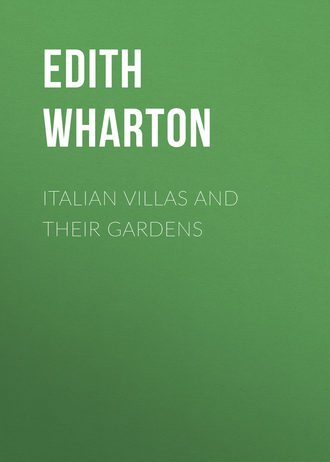 полная версия
полная версияItalian Villas and Their Gardens
Lante, doubly happy in its site, is as rich in shade as in water, and the second terrace, behind the pavilions, is planted with ancient plane-trees. Above this terrace rise three others, all wooded with plane and ilex, and down the centre, from the woods above, rushes the cascade which feeds the basin in the flower-garden. The terraces, with their balustrades and obelisks and double flights of steps, form a stately setting to this central château d’eau, through which the water gushes by mossy steps and channels to a splendid central composition of superimposed basins flanked by recumbent river-gods.
All the garden-architecture at Lante merits special study. The twin pavilions seem plain and insignificant after the brilliant elevations of the great Roman villas, but regarded as part of the garden-scheme, and not as dominating it, they fall into their proper place, and are seen to be good examples of the severe but pure style of the early cinque-cento. Specially interesting also is the treatment of the retaining-wall which faces the entrance to the grounds; and the great gates of the flower-gardens, and the fountains and garden-houses on the upper terraces, are all happy instances of Renaissance garden-art untouched by barocchismo.
At Lante, also, one sees one of the earliest examples of the inclusion of the woodland in the garden-scheme. All the sixteenth-century villas had small groves adjacent to the house, and the shade of the natural woodland was used, if possible, as a backing to the gardens; but at the Villa Lante it is boldly worked into the general scheme, the terraces and garden-architecture are skilfully blent with it, and its recesses are pierced by grass alleys leading to clearings where pools surrounded by stone seats slumber under the spreading branches.
The harmonizing of wood and garden is one of the characteristic features of the villas at Frascati; but as these are mostly later in date than the Lante grounds, priority of invention may be claimed for the designer of the latter. It was undoubtedly from the Italian park of the Renaissance that Le Nôtre learned the use of the woodland as an adjunct to the garden; but in France these parks had for the most part to be planted, whereas in Italy the garden-architect could use the natural woodland, which was usually hilly, and the effects thus produced were far more varied and interesting than those possible in the flat artificial parks of France.
II
VILLA D’ESTE
Of the three great villas built by cardinals beyond the immediate outskirts of Rome, the third and the most famous is the Villa d’Este at Tivoli.
Begun before 1540 by the Cardinal Bishop of Cordova, the villa became the property of Cardinal Ippolito d’Este, son of Alfonso I of Ferrara, who carried on its embellishment at the cost of over a million Roman scudi. Thence it passed successively to two other cardinals of the house of Este, who continued its adornment, and finally, in the seventeenth century, was inherited by the ducal house of Modena.
The villa, an unfinished barrack-like building, stands on a piazza at one end of the town of Tivoli, above gardens which descend the steep hillside to the gorge of the Anio. These gardens have excited so much admiration that little thought has been given to the house, though it is sufficiently interesting to merit attention. It is said to have been built by Pirro Ligorio, and surprising as it seems that this huge featureless pile should have been designed by the creator of the Casino del Papa, yet one observes that the rooms are decorated with the same fantastic pebble-work used in such profusion at the Villa Pia. In extenuation of the ugliness of the Villa d’Este it should, moreover, be remembered that its long façade is incomplete, save for the splendid central portico; and also that, while the Villa Pia was intended as shelter for a summer afternoon, the great palace at Tivoli was planned to house a cardinal and his guests, including, it is said, “a suite of two hundred and fifty gentlemen of the noblest blood of Italy.” When one pictures such a throng, with their innumerable retainers, it is easy to understand why the Villa d’Este had to be expanded out of all likeness to an ordinary country house.
The plan is ingenious and interesting. From the village square only a high blank wall is visible. Through a door in this wall one passes into a frescoed corridor which leads to a court enclosed in an open arcade, with fountains in rusticated niches. From a corner of the court a fine intramural stairway descends to what is, on the garden side, the piano nobile of the villa. On this side, looking over the gardens, is a long enfilade of rooms, gaily frescoed by the Zuccheri and their school; and behind the rooms runs a vaulted corridor built against the side of the hill, and lighted by bull’s-eyes in its roof. This corridor has lost its frescoes, but preserves a line of niches decorated in coloured pebbles and stucco-work, with gaily painted stucco caryatids supporting the arches; and as each niche contains a semicircular fountain, the whole length of the corridor must once have rippled with running water.
The central room opens on the great two-storied portico or loggia, whence one descends by an outer stairway to a terrace running the length of the building, and terminated at one end by an ornamental wall, at the other by an open loggia overlooking the Campagna. From this upper terrace, with its dense wall of box and laurel, one looks down on the towering cypresses and ilexes of the lower gardens. The grounds are not large, but the impression produced is full of a tragic grandeur. The villa towers above so high and bare, the descent from terrace to terrace is so long and steep, there are such depths of mystery in the infinite green distances and in the cypress-shaded pools of the lower garden, that one has a sense of awe rather than of pleasure in descending from one level to another of darkly rustling green. But it is the omnipresent rush of water which gives the Este gardens their peculiar character. From the Anio, drawn up the hillside at incalculable cost and labour, a thousand rills gush downward, terrace by terrace, channelling the stone rails of the balusters, leaping from step to step, dripping into mossy conchs, flashing in spray from the horns of sea-gods and the jaws of mythical monsters, or forcing themselves in irrepressible overflow down the ivy-matted banks. The whole length of the second terrace is edged by a deep stone channel, into which the stream drips by countless outlets over a quivering fringe of maidenhair. Every side path or flight of steps is accompanied by its sparkling rill, every niche in the retaining-walls has its water-pouring nymph or gushing urn; the solemn depths of green reverberate with the tumult of innumerable streams. “The Anio,” as Herr Tuckermann says, “throbs through the whole organism of the garden like its inmost vital principle.”
The gardens of the Villa d’Este were probably begun by Pirro Ligorio, and, as Herr Gurlitt thinks, continued later by Giacomo della Porta. It will doubtless never be known how much Ligorio owed to the taste of Orazio Olivieri, the famous hydraulic engineer, who raised the Anio to the hilltop and organized its distribution through the grounds. But it is apparent that the whole composition was planned about the central fact of the rushing Anio: that the gardens were to be, as it were, an organ on which the water played. The result is extraordinarily romantic and beautiful, and the versatility with which the stream is used, the varying effects won from it, bear witness to the imaginative feeling of the designer.
When all has been said in praise of the poetry and charm of the Este gardens, it must be owned that from the architect’s standpoint they are less satisfying than those of the other great cinque-cento villas. The plan is worthy of all praise, but the details are too complicated, and the ornament is either trivial or cumbrous. So inferior is the architecture to that of the Lante gardens and Caprarola that Burckhardt was probably right in attributing much of it to the seventeenth century. Here for the first time one feels the heavy touch of the baroque. The fantastic mosaic and stucco temple containing the water-organ above the great cascade, the arches of triumph, the celebrated “grotto of Arethusa,” the often-sketched fountain on the second terrace, all seem pitiably tawdry when compared with the garden-architecture of Raphael or Vignola. Some of the details of the composition are absolutely puerile—such as the toy model of an ancient city, thought to be old Rome, and perhaps suggested by the miniature “Valley of Canopus” in the neighbouring Villa of Hadrian; and there are endless complications of detail, where the earlier masters would have felt the need of breadth and simplicity. Above all, there is a want of harmony between the landscape and its treatment. The baroque garden-architecture of Italy is not without charm, and even a touch of the grotesque has its attraction in the flat gardens of Lombardy or the sunny Euganeans; but the cypress-groves of the Villa d’Este are too solemn, and the Roman landscape is too august, to suffer the nearness of the trivial.
III
FRASCATI
The most famous group of villas in the Roman country-side lies on the hill above Frascati. Here, in the middle of the sixteenth century, Flaminio Ponzio built the palace of Mondragone for Cardinal Scipione Borghese.4 Aloft among hanging ilex-woods rises the mighty pile on its projecting basement. This fortress-like ground floor, with high-placed grated windows, is common to all the earlier villas on the brigand-haunted slopes of Frascati. An avenue of ancient ilexes (now cruelly cut down) leads up through the park to the villa, which is preceded by a great walled courtyard, with fountains in the usual rusticated niches. To the right of this court is another, flanked by the splendid loggia of Vignola, with the Borghese eagles and dragons alternating in its sculptured spandrels, and a vaulted ceiling adorned with stucchi—one of the most splendid pieces of garden-architecture in Italy.
At the other end of this inner court, which was formerly a flower-garden, Giovanni Fontana, whose name is identified with the fountains of Frascati, constructed a théâtre d’eau, raised above the court, and approached by a double ramp elaborately inlaid in mosaic. This ornate composition, with a series of mosaic niches simulating arcaded galleries in perspective, is now in ruins, and the most impressive thing about Mondragone is the naked majesty of its great terrace, unadorned save by a central fountain and two tall twisted columns, and looking out over the wooded slopes of the park to Frascati, the Campagna, and the sea.
On a neighbouring height lies the more famous Villa Aldobrandini, built for the cardinal of that name by Giacomo della Porta in 1598, and said by Evelyn, who saw it fifty years later, “to surpass the most delicious places … for its situation, elegance, plentiful water, groves, ascents and prospects.”
The house itself does not bear comparison with such buildings as the Villa Medici or the Villa Pamphily. In style it shows the first stage of the baroque, before that school had found its formula. Like all the hill-built villas of Frascati, it is a story lower at the back than in front; and the roof of this lower story forms at each end a terrace level with the first-floor windows. These terraces are adorned with two curious turrets, resting on baroque basements and crowned by swallow-tailed crenellations—a fantastic reversion to mediævalism, more suggestive of “Strawberry Hill Gothic” than of the Italian seventeenth century.
Orazio Olivieri and Giovanni Fontana are said to have collaborated with Giacomo della Porta in designing the princely gardens of the villa. Below the house a series of splendid stone terraces lead to a long tapis vert, with an ilex avenue down its centre, which descends to the much-admired grille of stone and wrought-iron enclosing the grounds at the foot of the hill. Behind the villa, in a semicircle cut out of the hillside, is Fontana’s famous water-theatre, of which Evelyn gives a picturesque description: “Just behind the Palace … rises a high hill or mountain all overclad with tall wood, and so formed by nature as if it had been cut out by art, from the summit of which falls a cascade … precipitating into a large theatre of water. Under this is an artificial grot wherein are curious rocks, hydraulic organs, and all sorts of singing birds, moving and chirping by force of the water, with several other pageants and surprising inventions. In the centre of one of these rooms rises a copper ball that continually dances about three feet above the pavement, by virtue of a wind conveyed secretly to a hole beneath it; with many other devices for wetting the unwary spectators.... In one of these theatres of water is an Atlas spouting, … and another monster makes a terrible roaring with a horn; but, above all, the representation of a storm is most natural, with such fury of rain, wind and thunder as one would imagine oneself in some extreme tempest.”
Atlas and the monster are silent, and the tempest has ceased to roar; but the architecture of the great water-theatre remains intact. It has been much extolled by so good a critic as Herr Gurlitt, yet compared with Vignola’s loggia at Mondragone or the terrace of the Orti Farnesiani, it is a heavy and uninspired production. It suffers also from too great proximity to the villa, and from being out of scale with the latter’s modest elevation: there is a distinct lack of harmony between the two façades. But even Evelyn could not say too much in praise of the glorious descent of the cascade from the hilltop. It was in the guidance of rushing water that the Roman garden-architects of the seventeenth century showed their poetic feeling and endless versatility; and the architecture of the upper garden at the Aldobrandini merits all the admiration which has been wasted on its pompous theatre.
Another example of a théâtre d’eau, less showy but far more beautiful, is to be seen at the neighbouring Villa Conti (now Torlonia). Of the formal gardens of this villa there remain only the vast terraced stairways which now lead to an ilex-grove level with the first story of the villa. This grove is intersected by mossy alleys, leading to circular clearings where fountains overflow their wide stone basins, and benches are ranged about in the deep shade. The central alley, on the axis of the villa, leads through the wood to a great grassy semicircle at the foot of an ilex-clad hill. The base of the hillside is faced with a long arcade of twenty niches, divided by pilasters, and each containing a fountain. In the centre is a great baroque pile of rock-work, from which the spray tosses into a semicircular basin, which also receives the cascade descending from the hilltop. This cascade is the most beautiful example of fountain-architecture in Frascati. It falls by a series of inclined stone ledges into four oval basins, each a little wider than the one above it. On each side, stone steps which follow the curves of the basins lead to a grassy plateau above, with a balustraded terrace overhanging the rush of the cascade. The upper plateau is enclosed in ilexes, and in its centre is one of the most beautiful fountains in Italy—a large basin surrounded by a richly sculptured balustrade. The plan of this fountain is an interesting example of the variety which the Italian garden-architects gave to the outline of their basins. Even in the smaller gardens the plan of these basins is varied with taste and originality; and the small wall-fountains are also worthy of careful study.
Among the villas of Frascati there are two, less famous than the foregoing, but even more full of a romantic charm. One is the Villa Muti, a mile or two beyond the town, on the way to Grotta Ferrata. From the gate three ancient ilex avenues lead to the villa, the central one being on the axis of the lowest garden. The ground rises gradually toward the house, and the space between the ilex avenues was probably once planted in formal boschi, as fragments of statuary are still seen among the trees. The house, set against the hillside, with the usual fortress-like basement, is two stories lower toward the basse-cour than toward the gardens. The avenue to the left of the entrance leads to a small garden, probably once a court, in front of the villa, whence one looks down over a mighty retaining-wall at the basse-cour on the left. On the right, divided from the court by a low wall surmounted by vases, lies the most beautiful box-garden in Italy, laid out in an elaborate geometrical design, and enclosed on three sides by high clipped walls of box and laurel, and on the fourth by a retaining-wall which sustains an upper garden. Nothing can surpass the hushed and tranquil beauty of the scene. There are no flowers or bright colours—only the contrasted tints of box and ilex and laurel, and the vivid green of the moss spreading over damp paths and ancient stonework.
In the upper garden, which is of the same length but narrower, the box-parterres are repeated. This garden, at the end nearest the villa, has a narrow raised terrace, with an elaborate architectural retaining-wall, containing a central fountain in stucco-work. Steps flanked by statues lead up to this fountain, and thence one passes by another flight of steps to the third, or upper, garden, which is level with the back of the villa. This third garden, the largest of the three, was once also laid out in formal parterres and bosquets set with statues, and though it has now been remodelled in the landscape style, its old plan may still be traced. Before it was destroyed the three terraces of the Villa Muti must have formed the most enchanting garden in Frascati, and their plan and architectural details are worthy of careful study, for they belong to the rare class of small Italian gardens where grandeur was less sought for than charm and sylvan seclusion, and where the Latin passion for the monumental was subordinated to a desire for moderation and simplicity.
The Villa Falconieri, on the hillside below Mondragone, is remarkable for the wealth of its garden-architecture. The grounds are entered by two splendid stone gateways, the upper one being on an axis with the villa. A grass avenue leads from this gate to an arch of triumph, a rusticated elevation with niches and statues, surmounted by the inscription “Horatius Falconieris,” and giving access to the inner grounds. Hence a straight avenue runs between formal ilex-groves to the court before the house. On the right, above the bosco, is a lofty wall of rock, picturesquely overgrown by shrubs and creepers, with busts and other fragments of antique sculpture set here and there on its projecting ledges. This natural cliff sustains an upper plateau, where there is an oblong artificial water (called “the lake”) enclosed in rock-work and surrounded by a grove of mighty cypresses. From this shady solitude the wooded slopes of the lower park are reached by a double staircase so simple and majestic in design that it harmonizes perfectly with the sylvan wildness which characterizes the landscape. This staircase should be studied as an example of the way in which the Italian garden-architects could lay aside exuberance and whimsicality when their work was intended to blend with some broad or solemn effect of nature.
The grounds of the Villa Falconieri were laid out by Cardinal Ruffini in the first half of the sixteenth century, but the villa was not built till 1648. It is one of the most charming creations of Borromini, that brilliant artist in whom baroque architecture found its happiest expression; and the Villa Falconieri makes one regret that he did not oftener exercise his fancy in the construction of such pleasure-houses. The elevation follows the tradition of the Roman villa suburbana. The centre of the ground floor is an arcaded loggia, the roof of which forms a terrace to the recessed story above; while the central motive of this first story is another semicircular recess, adorned with stucco ornament and surmounted by a broken pediment. The attic story is set still farther back, so that its balustraded roof-line forms a background for the richly decorated façade, and the building, though large, thus preserves the airy look and lightness of proportion which had come to be regarded as suited to the suburban pleasure-house.
To the right of the villa, the composition is prolonged by a gateway with coupled columns surmounted by stone dogs, and leading from the forecourt to the adjoining basse-cour. About the latter are grouped a number of low farm-buildings, to which a touch of the baroque gives picturesqueness. In the charm of its elevation, and in the happy juxtaposition of garden-walls and outbuildings, the Villa Falconieri forms the most harmonious and successful example of garden-architecture in Frascati.
The elevation which most resembles it is that of the Villa Lancellotti. Here the house, which is probably nearly a century earlier, shows the same happy use of the open loggia, which in this case forms the central feature of the first story, above a stately pedimented doorway. The loggia is surmounted by a kind of square-headed gable crowned by a balustrade with statues, and the façade on each side of this central composition is almost Tuscan in its severity. Before the house lies a beautiful box-garden of intricate design, enclosed in high walls of ilex, with the inevitable théâtre d’eau at its farther end. This is a semicircular composition, with statues in niches between rusticated pilasters, and a central grotto whence a fountain pours into a wide balustraded basin; the whole being surmounted by another balustrade, with a statue set on each pier. It is harmonious and dignified in design, but unfortunately a fresh coating of brown and yellow paint has destroyed that exquisite patina by means of which the climate of Italy effects the gradual blending of nature and architecture.
V
GENOESE VILLAS
Genoa, one of the most splendour-loving cities in Italy, had almost always to import her splendour. In reading Soprani’s “Lives of the Genoese Painters, Sculptors and Architects,” one is struck by the fact that, with few exceptions, these worthies were Genoese only in the sense of having placed their talents at the service of the merchant princes who reared the marble city above its glorious harbour.
The strength of the race lay in other directions; but, as is often the case with what may be called people of secondary artistic instincts, the Genoese pined for the beauty they could not create, and in the sixteenth century they called artists from all parts of Italy to embody their conceptions of magnificence. Two of the most famous of these, Fra Montorsoli and Pierin del Vaga, came from Florence, Galeazzo Alessi from Perugia, Giovanni Battista Castello from Bergamo; and it is to the genius of these four men, sculptor, painter, architect, and stuccatore (and each more or less versed in the crafts of the others), that Genoa owes the greater part of her magnificence.
Fra Giovanni Angelo Montorsoli, the Florentine, must here be named first, since his chief work, the Palazzo Andrea Doria, built in 1529, is the earliest of the great Genoese villas. It is also the most familiar to modern travelers, for the other beautiful country houses which formerly crowned the heights above Genoa, from Pegli to Nervi, have now been buried in the growth of manufacturing suburbs, so that only the diligent seeker after villa-architecture will be likely to come upon their ruined gardens and peeling stucco façades among the factory chimneys of Sampierdarena or the squalid tenements of San Fruttuoso.
The great Andrea Doria, “Admiral of the Navies of the Pope, the Emperor, the King of France and the Republic of Genoa,” in 1521 bought the villas Lomellini and Giustiniani, on the western shore of the port of Genoa, and throwing the two estates together, created a villa wherein “to enjoy in peace the fruits of an honoured life”—so runs the inscription on the outer wall of the house.
Fra Montorsoli was first and foremost a sculptor, a pupil of Michelangelo’s, a plastic artist to whom architecture was probably of secondary interest. Partly perhaps for this reason, and also because the Villa Doria was in great measure designed to show the frescoes of Pierin del Vaga, there is little elaboration in its treatment. Yet the continuous open loggia on the ground floor, and the projecting side colonnades enclosing the upper garden, give an airy elegance to the water-front, and make it, in combination with its mural paintings and stucco-ornamentation, and the sculpture of the gardens, one of the most villa-like of Italian villas. The gardens themselves descend in terraces to the shore, and contain several imposing marble fountains, among them one with a statue of Neptune, executed in 1600 by the Carloni, and supposed to be a portrait of the great Admiral.









